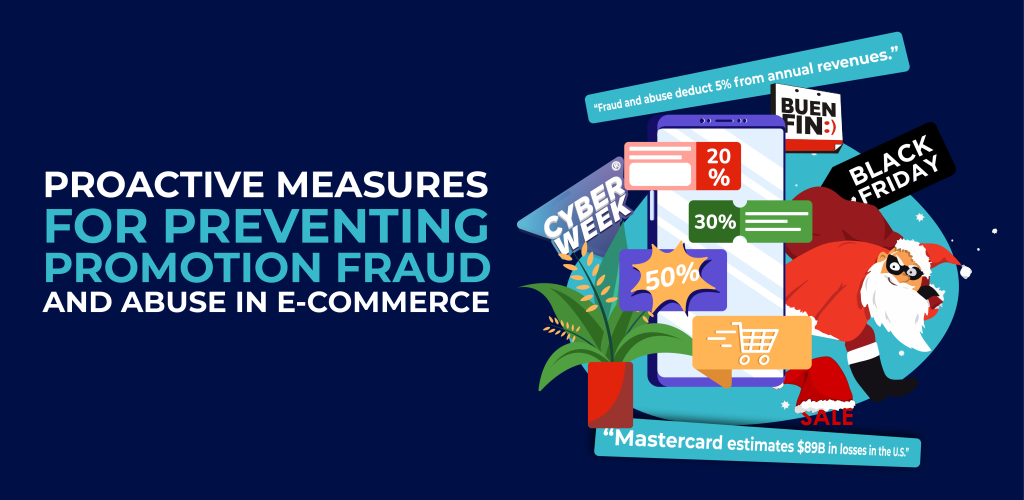
Proactive Measures for Preventing Promotion fraud and abuse in E-Commerce
Managing eCommerce promotions is challenging due to the need to attract genuine customers while preventing fraudulent activities. U.S. businesses are highly susceptible to fraud and abuse, which costs them an estimated 5% of their annual gross revenue according to a report by the BFP.
Diversity and Complexity of Promo Abuse Fraud
In the realm of eCommerce, promo abuse fraud is a chameleon, constantly shifting its appearance. It ranges from individuals creating multiple fake accounts to leverage sign-up bonuses to more organized groups orchestrating complex schemes that can include exploiting referral incentives. Fraudsters may also collude with return policies, effectively turning these into opportunities for theft.
Another common tactic involves ‘coupon stacking,’ where users combine multiple promotions to receive discounts or benefits not intended by the retailer. There are also instances of ‘price arbitrage,’ where abusers purchase items using discounts or promotions and resell them at a higher price.
Enhancing Promo Abuse Fraud Prevention
In combating promo abuse fraud, a dedicated prevention team armed with cutting-edge technology is essential. Tools like FUGU analyze transactions throughout their lifecycle, detecting even the most sophisticated fraud by correlating orders with complex indicators. This proactive approach, supported by machine learning, enables rapid detection and response, ensuring that eCommerce businesses can adapt swiftly to emerging fraud tactics and maintain robust defenses.
The Significant Impact of Promotional Fraud
The landscape of eCommerce is facing a significant threat from promotional fraud, with Mastercard projecting losses in the U.S. exceeding $89 billion which reflects up to 1.2% of revenue. This alarming figure reflects a critical vulnerability, especially in promotions that offer substantial rewards or discounts, which tend to attract sophisticated fraud attempts. High-value promotions are not just a magnet for higher customer engagement but also for illicit activities that can lead to considerable financial loss and potential damage to a brand’s reputation. The enormity of this challenge accentuates the essential need for robust fraud detection and strategic preventive actions.
When a significant portion of your promotional budget is lost to fraud, your campaigns fail to achieve the intended outcomes. Bogus accounts absorb the benefits meant for new customers, resulting in a higher actual cost per new customer. This complicates decision-making for future campaigns.
The Nuances of Promotion Abuse
Addressing promotion abuse requires a sophisticated strategy, especially in the critical stages of pre-checkout and post-checkout. In the pre-checkout phase, FUGU’s data collection is vital, focusing on capturing device fingerprints and analyzing transaction velocities to connect seemingly disparate transactions.
The post-payment analysis, however, is where the depth of data really comes into play. It’s here that we capture a wealth of information necessary to determine the risk level of an order. By scrutinizing customer behavior patterns and identifying anomalies, we can discern with greater accuracy whether an activity is fraudulent. This phase is not just about detection; it also involves a detailed examination of the transaction to understand the ‘how’ and ‘why’ behind a potentially risky order. All of this is achieved without disrupting the shopping experience for legitimate customers, ensuring that security measures enhance rather than hinder the customer journey.
The prevention team must have a deep understanding of promotional dynamics to differentiate between legitimate customer behavior and abuse. This knowledge is key to minimizing false positives, which can be as damaging as fraud itself by eroding customer trust and discouraging future purchases. A sophisticated balance must be struck to protect the business from losses due to fraud while maintaining a positive and seamless experience for genuine customers. This balance is critical in ensuring that fraud prevention efforts bolster the business’s integrity and customer relations rather than unintentionally harming them.
The effectiveness of managing promotion abuse lies in a seamless blend of sophisticated technology and human insight. By integrating advanced detection tools, businesses can scrutinize transactional data for signs of abuse and fraud. Meanwhile, a well-informed fraud prevention team, deeply familiar with the intricacies of promotional campaigns, can fine-tune these tools to distinguish between fraudulent and legitimate activity accurately. Working in concert with marketing, they ensure that promotional strategies are both appealing to customers and resilient to exploitation. This collaborative approach not only protects the business but also fosters a trustworthy shopping experience, striking the right balance between protection and customer experience.